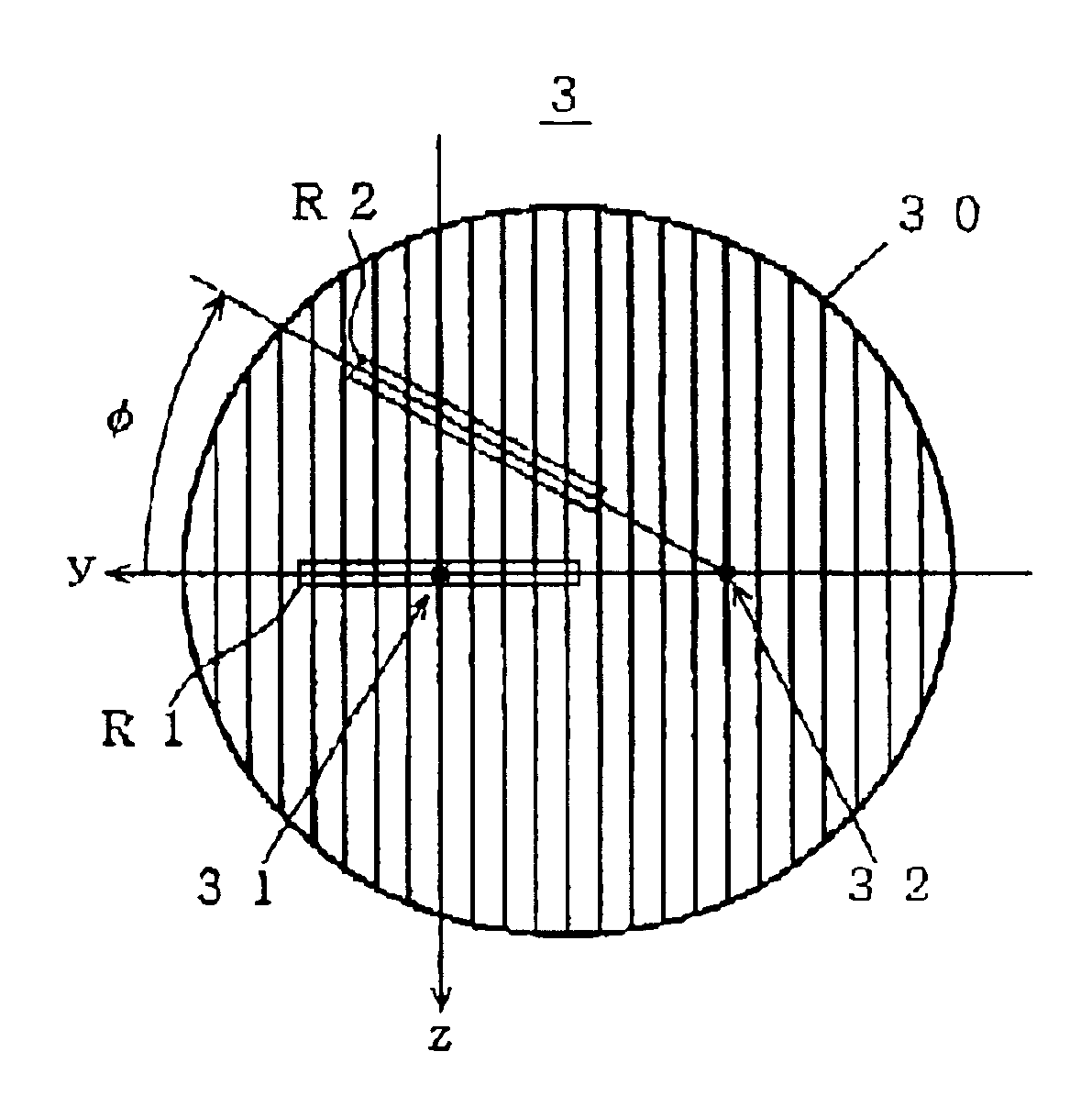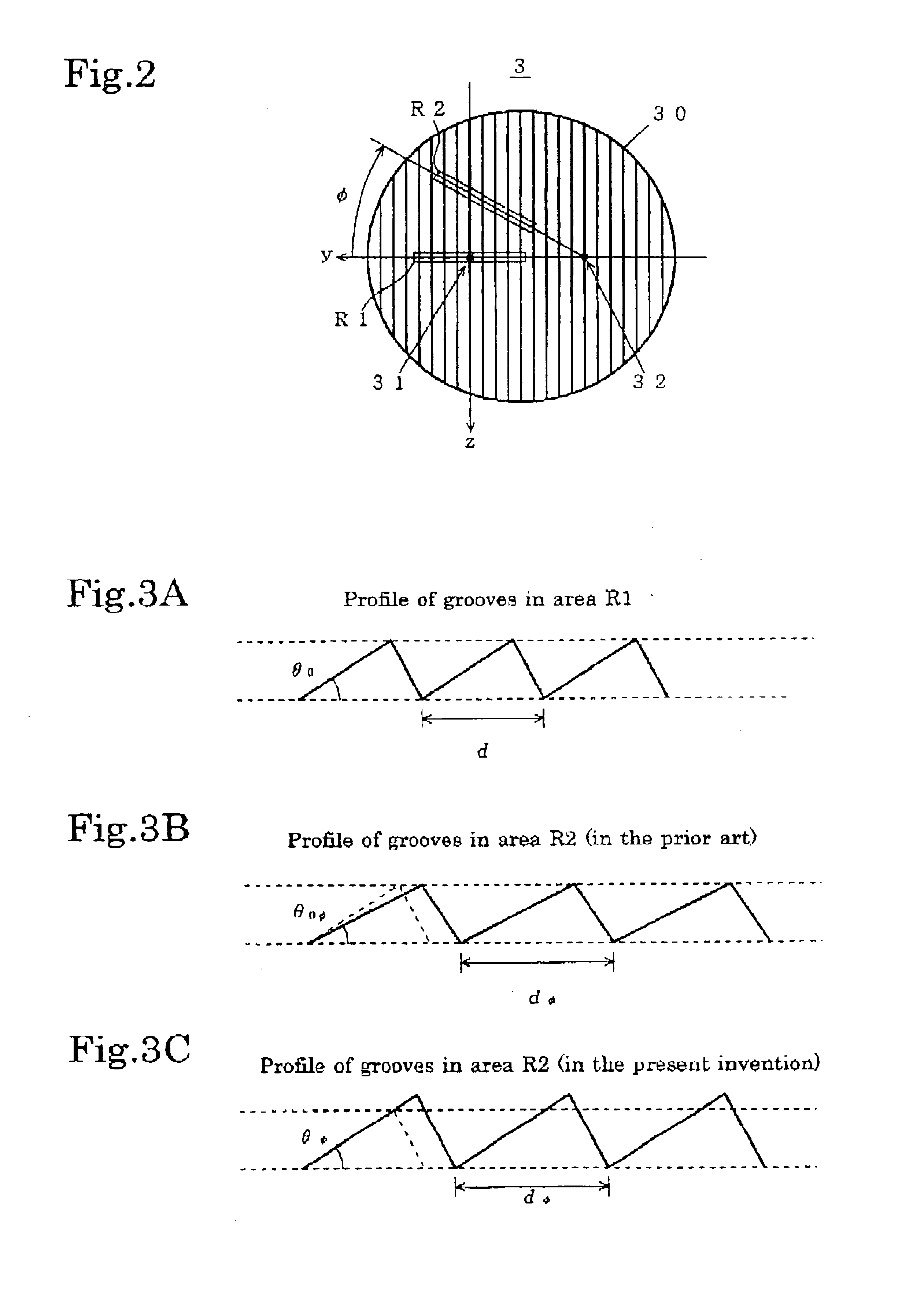Plane diffraction grating based on surface normal rotation and its application to an optical system
a technology of normal rotation and diffraction grating, which is applied in the direction of optical radiation measurement, instruments, spectrometry/spectrophotometry/monochromators, etc., can solve the problem of only maximizing diffraction efficiency at a certain wavelength, and achieve the effect of maximizing diffraction efficiency
- Summary
- Abstract
- Description
- Claims
- Application Information
AI Technical Summary
Benefits of technology
Problems solved by technology
Method used
Image
Examples
first example
An example using a blazed type diffraction grating is first described referring to FIGS. 2 and 3A-3C. FIG. 3A show the profile of the grooves of the diffraction grating in the area R1, in which the blaze angle is denoted as θ0, and the grating constant is denoted as d. Supposing the light diffracted by the area R1 has the wavelength λ0, it is known that the diffraction efficiency in maximized for the light of wavelength λ0 by setting the blaze angle θ0 as follows: θ0=α+β2.(1)
In conventional blazed tape diffraction gratings, the blaze angle is the same throughout the entire surface 30. When such a diffraction grating is used in the above described monochromator, the diffraction efficiency is not maximized for the light of wavelengths other than λ0 (or at the position φ≠0). This is explained as follows: When the diffraction grating 3 is at the position φ (≠0) and the incident light beam illuminates the area R2, the profile of the grooves along the length of the area R2 is as shown by ...
second example
Another example using a blazed type diffraction grating is then described. The surface of the grooves of the diffraction grating 3 is covered with a multiple-layer coating to improve reflectivity and thus the diffraction efficiency. Suppose the unit thickness of the multiple-layer coating in the linear area R1 at the rotational position φ=0 is db0. In order to improve the diffraction efficiency for the light of wavelength λ0, the unit thickness db0 should satisfy the following Bragg equation:
mbλ0=2db0Rα0 cos(α−θ0), (6)
where Rα0 is given by
Rα0=√{square root over (1−(2δ−δ2) / cos2α)}, (7)
in which δ=1−n, where n is the average refractive index of the multiple-layer coating for wavelength λ0.
In the linear area R2 of the rotational position φ(≠0), the unit thickness dbφ of the multiple-layer coating for the improved diffraction efficiency for the wavelength λ is calculated as follows: When the rotational position of the diffraction grating 3 is φ, the angle between the incident ray and t...
third example
The present invention is embodied in a monochromator using a laminar type diffraction grating. It is generally known (for example, K. H. Hellwege, Z. Phys. Vol. 106(1937), pp. 588-596) that the diffraction efficiency for the primary order diffraction light of wavelength λ0 is maximized and the diffraction light of even-number orders are decreased by setting the depth h0 of the grooves of the laminar type diffraction grating as: h0=λ02(cos α+cos β).(11)
The wavelength λ corresponding to the rotational position φ of the diffraction grating 3 is given by λ=λ0cos ϕ.(12)
The optimal depth hφ of the grooves in the linear area R2 of the rotational position φ for maximizing the diffraction efficiency is hϕ=λ02(cos α+cos β)cos ϕ.(13)
By setting the depth of the grooves in the area R2 at the optimal depth hφ given above, the diffraction efficiency is always maximized irrespective of the rotational position of the diffraction grating 3 and for any scanning wavelength λ.
PUM
 Login to View More
Login to View More Abstract
Description
Claims
Application Information
 Login to View More
Login to View More - R&D
- Intellectual Property
- Life Sciences
- Materials
- Tech Scout
- Unparalleled Data Quality
- Higher Quality Content
- 60% Fewer Hallucinations
Browse by: Latest US Patents, China's latest patents, Technical Efficacy Thesaurus, Application Domain, Technology Topic, Popular Technical Reports.
© 2025 PatSnap. All rights reserved.Legal|Privacy policy|Modern Slavery Act Transparency Statement|Sitemap|About US| Contact US: help@patsnap.com



